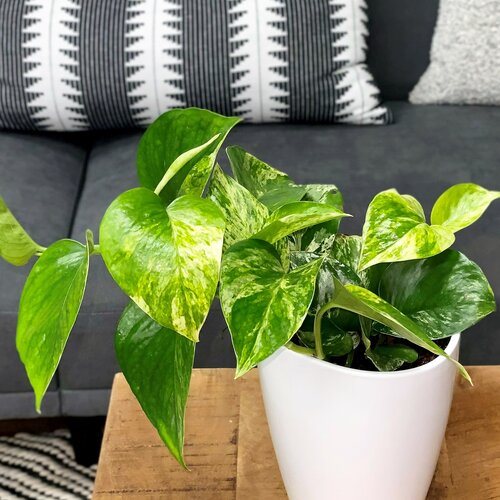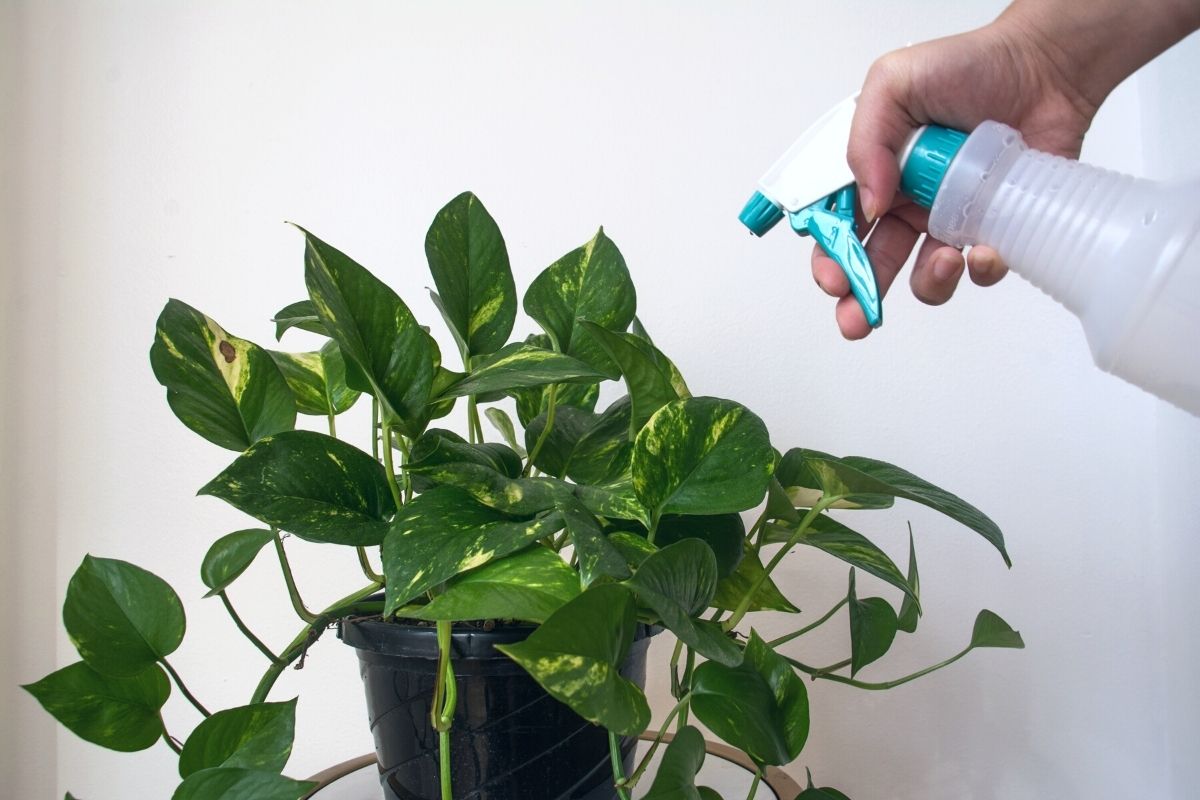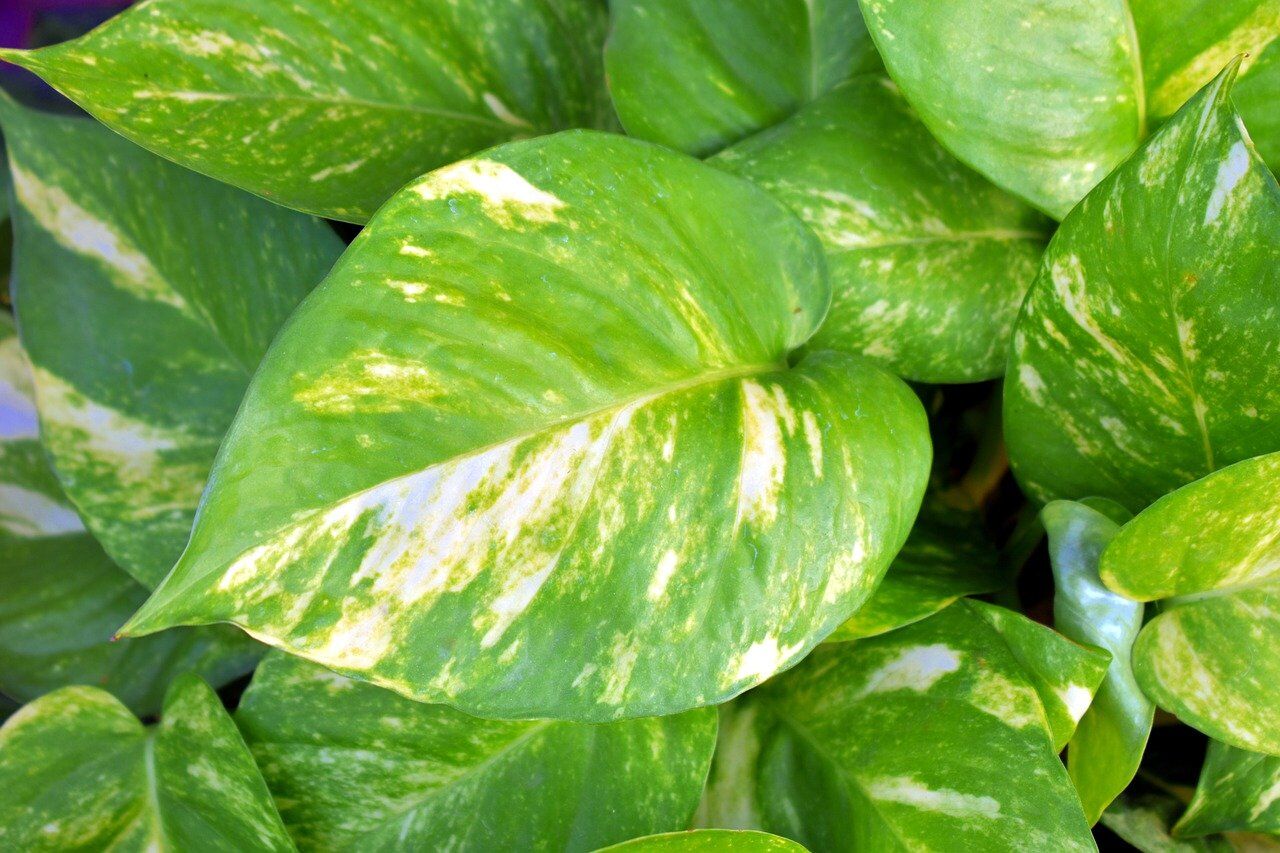
In the spring and summer, water pothos plants once every seven days, and once every 10 to 14 days in the winter. Before watering pothos plants once more, let the top inch of the soil dry out. Always give them a good soak. To establish a humid microclimate, mist the pothos leaves with water once every seven days.
Continue reading to find out the best way to water pothos plants, also known as devil’s ivy, as well as the warning indications of overwatering and underwatering.
Table of Contents
How Often to Water Pothos Indoors
Pothos is a plant that is indigenous to warm, tropical and subtropical regions of Asia and Oceania. It thrives in conditions with moderate humidity, protection from strong air currents, and soil that drains well.
The pothos plant is quite versatile and can grow in a wide range of environments, but it needs evenly moist soil that dries out somewhat in between waterings.
The leaves of the pothos might turn brown as a symptom of drought stress if the potting soil entirely dries out for an extended period of time if the humidity is very low. However, pothos leaves become yellow and droop if the soil is too wet rather than just moist, which may be an indication of root rot.
It’s crucial to match the regular watering cycle and moisture levels in the potting soil of the pothos’ native environment in order to water them appropriately.
Pothos should receive a good soak of water before the top inch of the potting soil dries out. Typically, this entails watering pothos plants once every 10 days in the winter and once every 7 days during vigorous growth in the spring and summer.
Since homes typically have low humidity, especially during the winter when air conditioning and other heat sources are used more frequently, it is frequently required to sprinkle the leaves of indoor pothos plants with water.
Once a week misting the leaves of your pothos will assist to counteract the drying effects of air currents and will help to recreate the tropical forest environment of the plant by creating a damp microclimate.
According on your temperature and conditions, a number of factors can affect how frequently pothos need be watered, including:
- your climate’s typical temperature and humidity range.
- The pot or container’s size (smaller pots and containers faster then larger pots).
- Whether pothos is near sources of heat when indoors and in the air current of air conditioning.
- the potting soil’s capacity to hold moisture.
Teel the top inch of the potting soil with your finger to measure the level of moisture to determine how frequently to water pothos for your individual climate and conditions in your home.
If the soil feels wet, wait a few days before watering again. Then, water deeply and thoroughly when the soil feels as though it is drying out.
You may create a watering schedule that is tailored to your environment and the circumstances inside your home after you know how long it typically takes for the top inch of soil to dry.
How Often to Water Pothos in Winter
Due to shorter days and decreased light levels in the winter, pothos needs to be watered less frequently.
In the Winter, watering the pothos plant once every 10 to 14 days often satisfies its water needs and avoids any issues related to overwatering, such as root rot.
However, it’s crucial to think about where the pothos is placed in your house because the soil can dry up more quickly if it’s close to a heat source or in the route of forced air.
The pothos should keep healthy and green throughout the Winter as long as the top inch of soil dries out between waterings, you give it a nice bath, and you spritz the leaves once a week.
Signs of Over Watering and Under Watering Pothos
The leaves of a pothos that has received too much water start to yellow and droop, giving the plant a dying aspect.
However, slow-draining soils, pots without drainage holes in their bases, the use of saucers, trays, and decorative outer pots can all result in too much water to pool around the roots of your pothos, which leads to yellow leaves and root rot. This problem is not limited to overwatering.
The roots of the pothos plant cannot handle being in soggy soil, thus it needs soil that drains effectively.
When there is too much water surrounding the root ball, oxygen cannot enter the soil and root respiration is prevented, interfering with the roots’ ability to absorb water and nutrients, turning the leaves yellow, and finally leading to root rot.
Wait until the soil feels dry before watering pothos since it is more robust to drought stress than overwatering.
Underwatering in pothos causes the leaves to turn brown and yellow and to visibly shrivel or curl.
Rather perplexingly, both overwatering and underwatering can cause pothos leaves to turn yellow, but you can readily identify the source by feeling the soil’s dampness through the drainage hole in the pot’s base.
In contrast to dry soil, which suggests insufficient watering or watering too gently, swampy or soggy soil is a sign of overwatering.
For under-watered pothos, submerge the pot in a basin of water for around 10 minutes to ensure that the soil is well moistened and the roots are able to absorb the water they sorely need.
The pothos should recover if you increase the frequency of watering, always use a good soak, and spritz the leaves once a week.
Method for Watering Pothos
While weather, temperature, and humidity can all have an impact on how frequently you water pothos plants, the amount of water they require is constant.
Give your pothos a good soak, letting any extra water drain out the bottom of the pot.
By watering in this manner with a thorough soak, you can make sure that the potting soil is evenly saturated and the pothos roots can absorb the liquid they need.
Pothos leaves may turn brown, yellow, or wilt owing to drought stress if the soil is watered too lightly, which results in only the top inch or two of the soil staying moist and the water not reaching the roots.
Pothos prefer a certain amount of soil moisture in their original tropical environment, which may be replicated by watering thoroughly so that all of the potting soil is continually moist.
Well Draining Soil Prevent Pothos Dying from Over Watering
Pothos must be planted in the proper well-draining potting mix in order to be watered to obtain the ideal moisture balance.
In order for the roots to be able to absorb the water they need, the ideal potting mix should maintain an aerated, porous, well-draining structure while holding onto some moisture.
For the best potting mixture, combine 3 parts regular house plant potting soil or compost with 1 part perlite for improved soil structure and additional drainage.
Although pothos is a hardy plant that can adapt to most soil types, adding perlite guarantees that water can drain away from the roots effectively to prevent root rot.
The potting soil can trap too much water around the roots of your pothos if it is compacted and impermeable, which will harm the plant by turning the leaves yellow.
With the appropriate soil mixture, it is much simpler to keep your indoor pothos plants at the ideal moisture level and avoid any negative effects of overwatering to keep your plant healthy.
Water Pothos in Pots with Good Drainage
The best approach to make sure the pothos soil is evenly saturated so that the roots can absorb the fluids they need is to water with a really good soak so that extra water trickles from the base of the pot or container.
Without drainage holes, water will pool around the roots of your pothos plant, which will lead to root rot.
In your plant planter, water may still collect around the roots if
- Roots or compacted dirt have filled the drainage hole in the pot’s or containers’ base. If you observe that the soil is draining slowly, you should investigate whether the hole in the base needs to be cleaned out to allow water to drain correctly.
- trays and saucers beneath your pots Under your pothos plant, saucers or trays avoid water from pouring into your home, but you should frequently drain them to keep the soil from becoming too wet for the roots of the plant.
- outside pots that add style. In order to prevent water from escaping and causing root rot, pothos are occasionally marketed in beautiful outer pots without drainage holes in their bases. To avoid this, either frequently empty the pot of water, or plant in a pot with drainage holes in the base.
Key Takeaways:
- In the Spring and Summer, water pothos plants as frequently as once every seven days, and in the Winter, as frequently as once every 10 to 14 days. To produce the humid climate that pothos plants prefer, always give them a good bath and spritz the leaves with water once every seven days.
- Pothos should be planted in properly draining soil. To stop root rot from killing pothos, the potting soil’s drainage can be improved using perlite.
- To avoid standing water collecting around the root ball, which can lead to root rot, plant pothos in containers with drainage holes at the bottom.
- Underwatered pothos plants exhibit browning, yellowing, and withering of the foliage, whilst overwatered pothos exhibits yellowing and drooping of the leaves. When the top inch of soil seems dry, water pothos plants thoroughly. For pothos plants, once per week in the spring and summer and once every ten days in the winter, is the recommended quantity of watering.
FAQ
Can you overwater a pothos?
Most frequently, over or underwatering causes yellowing. If a leaf has both yellow and brown coloring, overwatering is probably to blame. Underwatering may be the culprit if you see yellow leaves as well as some brown crispy areas on other leaves.
Do pothos like being misted?
As you place the plant, make sure the water doesn’t touch the pot. Additionally, avoid misting plants like succulents, the dragon tree (Draceana marginata), the fiddle leaf fig (Ficus lyrata), the yucca, the pothos, the ponytail plant (Beaucarnea recurvata), the cissus, and the spider plant, which don’t require a lot of moisture.
Can pothos recover from overwatering?
A Pothos plant can be saved in three different methods. First, drain any extra water and let the soil air-dry. You can also repot the plant after removing as much soil as you can without disturbing the root ball. If the plant develops root rot, however, cut it into pieces and place them in soil or water to create new plants.
How often should pothos be misted?
Just remember that Pothos doesn’t tolerate being overwatered very well. In dry climates, you can spray once every two to three days, but first you must gauge the local humidity levels.
What happens if I over water my pothos?
An overwatered pothos plant’s leaves frequently get water blisters or brown stains. When the roots of the pothos eat more water than the leaves can use, the cells burst, resulting in water blisters or water-soaked brown blotches, which is known as leaf edema.


